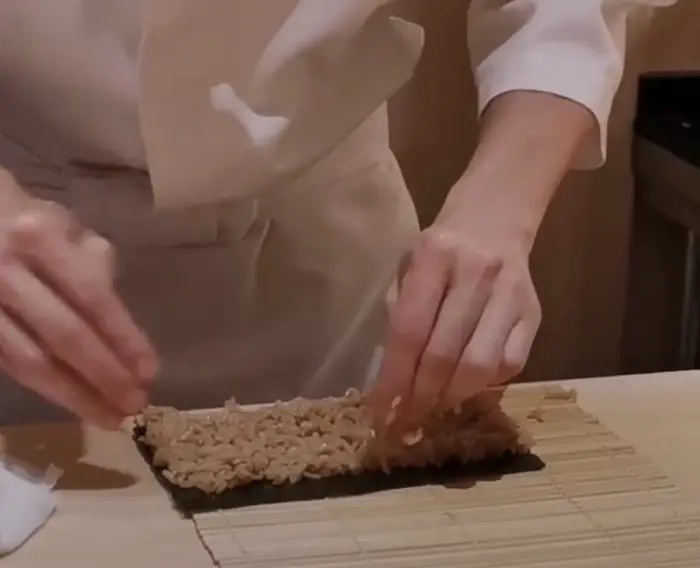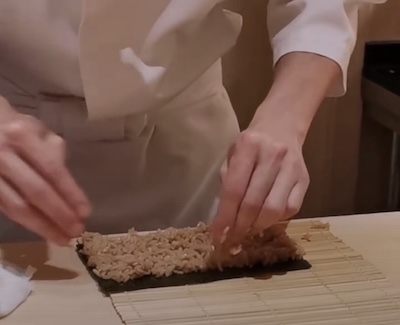We are reader supported. When you purchase through links on our site, we may earn an affiliate commission. Also, as an Amazon affiliate, we earn from qualifying purchases.

When dining out at any traditional Japanese sushi restaurant, I feel awed by how they turn simple things into a sheer delicacy. Take the dried shavings of gourd or calabash fruit (Kampyo) for example, seemingly humble food that is hydrated, stewed and marinated in soy sauce and sugar to make it taste incredible.
If you love eating sushi while dining out, chances are you have tasted this ingredient in your futomaki roll. It is a common filling used alongside tamagoyaki, cucumber, and other vegetables. However, finding Kampyo in your local grocery store may not be easy if you live outside Japan.
So, if you are an ardent foodie and cooking enthusiast too then you may want to order dehydrated Kampyo online to try your hand at making delicious Kampyo sushi. Meanwhile, let’s take a closer look at Kampyo and get to know it better.
Contents
What is Kampyo?
Kanpyō or kampyo is a traditional ingredient (see Amazon) used in Japanese food since the Edo period. They are the dried shavings of calabash fruit, which belongs to the gourd family. They are typically sold dehydrated and are meant to be cooked before using in any dish. In their dehydrated form, they appear like long, beige colored, and ribbon-like strips bundled together.
Originally cultivated in the Osaka region, these dried gourd strips are now considered as the specialty of Tochigi Prefecture. The white flowers of the plant bloom on summer evenings and wither out overnight, however the vines brim with vigor. The vines can grow as tall as 20 meters and the flesh of the fruit can weigh around 6 to 7 kgs.
The harvesting season for the plant is from late July to September. The white flesh of the bottle gourd is cut into strips – 3 cm wide and 3 mm thick. They are either dehydrated in a machine or sun-dried naturally. While this food is used in Japan as a part of their traditional cuisine, the dried gourd is used in other parts of the world as pieces of art or containers.
Before using kampyo as an ingredient in sushi rolls, they need to be soaked, cooked and seasoned properly. Although this is a labor-intensive process, the results are worth the effort. Preparing kampyo may look easy but it requires the perfect timing and exact measurements.
Today, I will share with you the secret recipe my Japanese friend gave me for cooking Kampyo at home:
Preparing Stewed Kampyo For Sushi
You will need:
- 1 bag of Kampyo
- 1-liter water
- 1 tablespoon salt
- 3 tablespoon of mirin
- 3 tablespoon soy sauce
- Japanese soup stock (250 ml)
- 3 tablespoon sugar (coarse, medium soft texture)
Instructions
As the kampyo strips are dehydrated, you need to first soak them in water for 3 hours. Make sure you change the water in between.
Drain the water and sprinkle some salt over the soaked strips. Rub with salt thoroughly and rinse under running tap water.
Again take a pan and fill with water. Add some salt and cleaned kampyo to water and bring to boil. When water starts boiling, lower the heat and let it simmer for 5 minutes.
To check whether the gourd strips are cooked or not, press your nails against it. If it leaves a mark then it is cooked well.
Squeeze the kampyo tightly to remove excess water. Use a cheesecloth to protect your hands because it’s hot
Now, add mirin, soy sauce, and sugar to the dashi soup stock and bring to boil. Add the well-drained calabash shavings
Stir gently with the lid covered and simmer over low heat until the water is completely reduced.
Simmer slowly for 15 minutes and then check the taste. Steam it after removing from the heat. The kampyo should taste even.
Kampyo Maki In Japan
If you have ever been to Japan, you probably know that their sushi is a lot different from what you see and get in the U.S. Americans have a glossy and magnified version of everything so you can expect the sushi rolls to have many ingredients and slathered with sauces.
In Japan, sushi is referred to practically anything that is served with the seasoned vinegared rice. The maki rolls are humble with just one or two ingredients, enabling you to appreciate the taste of each. When they use kampyo in sushi, it is not necessarily paired up with a fish or seafood.
The Kampyo maki is the most basic representation of kampyo sushi and it contains only three simple ingredients – vinegared sushi rice, kampyo, and nori sheet. In some places, the chef might include prawns or extra flavorings but this is just an option.

If you visit a traditional restaurant, you will find that Kampyo maki is served towards the end of the meal for certain reasons. First, it offers a mild and pleasant flavor to clear the palate, and secondly, it helps the guests feel fuller if they are still hungry after a meal.
According to master chefs, Kampyo maki is deliberately prepared in a way to be not so flavorful. It offers a nice mixture of delicious flavors and savory undertones to give you an enjoyable experience.
Futomaki Roll Containing Kampyo
While you can enjoy a kampyo sushi with just the three ingredients rolled into a nice sushi roll, special occasions and events call in Japan for futomaki rolls and kampyo is a popular ingredient. An important tip about futomaki rolls is that you must ensure that no ingredient overpowers the other.
Some of the common ingredients used in futomaki rolls are kampyo, unagi, mitsuba, and sakura denbu. Here’s the recipe to help you get started.
What you will need:
- 2 cups seasoned sushi rice
- 4 sheets nori (seaweed)
- 1 ripe but firm avocado (seed and skin removed, finely sliced)
- Half cucumber, cut into strips
- Half lb imitation crab
- 1 packet kampyo (cooked as per above instructions)
- 1 carrot cut into thin strips
Instructions
First, you need to prepare sushi rice and season it with rice vinegar, sugar, and salt. I have created an in-depth article on how to cook sushi rice in a cooker and pot with step by step instructions.
Toast the Nori slightly in a preheated oven for a few minutes. Be careful to not over roast or it may become too brittle. I suggest preheating the oven for 2 minutes at 300 F.
Place the bamboo mat on the table and keep the Nori sheet over the mat. Take a medium ball of sushi rice and spread it over the Nori sheet evenly
Now arrange the fillings in a straight line, towards the center of the Nori sheet. Now lift the bamboo mat and start rolling to make a compact cylinder.
Be careful while making a futomaki roll as it contains several ingredients together. Press gently to ensure that the fillings are held together tightly.
If you don’t have a bamboo mat, you may use other substitutes instead. I have compiled a list of easily available items in the kitchen that can be used as a bamboo sushi mat.
Now, slice the roll into 4-6 pieces using a sharp Japanese knife. Remember to moisten the blades to get a smooth cut.
Kampyo Substitutes For Sushi Rolls
While kampyo does not have a distinct flavor, the seasoning makes it taste sweet and savory. If you don’t get kampyo in the grocery store near you, it’s easy to replicate the taste with an old cucumber cooked in mirin and soy sauce in the same way. While you will miss the chewiness of kampyo, cucumber will give you a good balance of textures.
You can also replicate a similar taste using other mild vegetables easily available at the local market. Raw carrot can also be prepared in the same way as calabash shavings and the end results are utterly delicious.
In a futomaki roll, you will hardly notice the difference if you substitute kampyo with something else. However, if futomaki is not your style and you prefer the single-ingredient roll instead, you may try making cucumber maki roll for a fresh and crispy taste.
A Brief About The History Of Kampyo
About 280 years ago, during the Shotoku epoch, the feudal Tadahide Torii was the owner of Omi province and he also won over the Simotsuke province. At that time, he had ordered Kampyo seeds to be delivered from Manakuchi to Mibu.
There’s another claim regarding the origin of kampyo, although evidence for both are missing. According to the second version, the most popular manufacturer of kampyo is the southern region of Tochigi prefecture. This is one of the most favorable areas in Japan for calabash fruit cultivation.
Kampyo became famous in the Edo Period (1603-1868)when it was reserved as a refined food for the elite and upper classes. This valuable and appealing fruit carries the tradition and history spanning more than 300 years.
Related Questions
What other dishes use kampyo (calabash shavings)
The seasoned calabash fruit shavings find their place in a variety of other dishes other than sushi rolls. They are used in a special auspicious festive dish called the salmon kombu roll. They are also used in chirashi sushi bowl and pasta to enhance the flavor on happy occasions.
Why does kampyo make you feel fuller
When you consume kampyo sushi, the filling expands after you eat. As a result, it makes you feel fuller for longer. It not only aids in digestion but also helps with weight loss.
How long can prepared kampyo last?
Hydrating and preparing kampyo to be used in sushi and other recipes is a labor-intensive process. Hence, you can prepare them and store in airtight ziplock bags inside the refrigerator. They can last for about one week and you can use this readymade kampyo anytime you are in the mood for sushi. However, let’s not forget that freshly made kampyo always tastes better than the refrigerated one.
How long can the dried shavings of calabash last?
The dehydrated strips of calabash can last for about a year. If you have opened the packet, make sure you transfer the remaining contents in an airtight container.
Where to buy kampyo
As kampyo is not a popular ingredient in the US, you will need to look for it in the Asian grocery stores. You can also buy them online for a couple of dollars and have them shipped to you. More than anything else, the authentic taste of kampyo will remind you of good old times if you are Japanese.
What’s the texture and taste of kampyo
The prepared shavings of calabash have a chewy texture that pairs well with vinegared rice and other ingredients in the traditional futomaki roll. In terms of flavor, it does not have its own characteristic taste but takes up added flavors when soaked in mirin and soy sauce.

